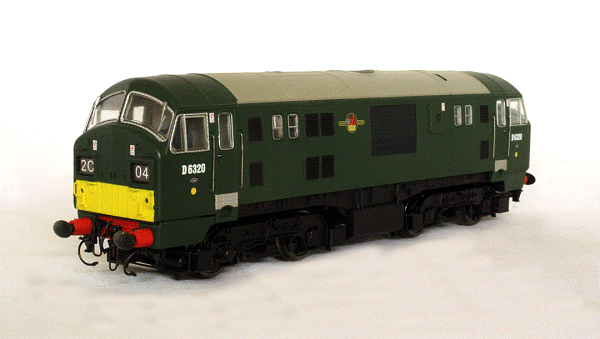Steve Johnson Modelmaker
|
|
North
British Class 22 B-B Diesel-Hydraulic
Dapol Class 22 The North British Class 22 locomotive was styling to the Class 21/29 by the same company. The main difference is that it was slightly shorter and had hydraulic transmission. The class gained the nickname of 'baby warships', due to the similarity in styling to the larger Class 41 'Warship' class. The first batch of locomotives had headcode disc indicators and communicating doors. Later batches featured the 4 digit split headcode boxes, either side of the door. Earlier disc locomotives were converted to 4 digit boxes later. Initially a few problems were encountered with the transmission, but these were eventually solved and the class settled down to a fairly reliable existence. Deemed as none standard, all had gone by 1971. Dapol have produced a model of this class in both disc and headcode versions. Featuring a die cast chassis, centrally mounted can motor and flywheels driving the gear towers on top of the bogies. The model has the correct spoked wheels. Provision for DCC was made. The one piece moulded body has numerous detail pieces added and removable valances. Performance is smooth and quiet and the model features working lights. Now, although the model looks good, with the 'face' captured well, it does have a few shortcomings. The removable valances are a good idea, but are poorly executed. In real life, the locomotives started with them all fitted and ended up with various combinations of sections, or none at all. Unfortunately, the ones supplied with the model are a poor fit, especially if you want them all on, as I do. For one thing, they keep falling off! The headcode display and lighting is also very poor. For some reason Dapol decided to go with 'stick on' transparent plastic panels. A variety is supplied, but the idea does just not work. The black panel has clear characters, so with the lights off, you don't get the white characters. With the lights on, the illumination is dull and there is light bleed around the edges of the plastic. I have modified my model to have specially printed white on black panels inserted behind the 'glass' of the indicator box. The lighting has also been modified so that an LED is behind each panel. The result is a brighter, more even and realistic looking display. The other 'missing' item is the Multiple Unit coupling symbols. The first five had Orange Square codes, the subsequent versions had White Diamond codes. Two symbols were positioned on the buffer beam either side of the drawhook. Not immediately obvious perhaps, but easily rectified with suitable transfers. Having said all that, I do pity manufacturers who attempt something like a Class 22, especially as non survived to measure up. For a small class, there was enormous variation in details, such as headcode box size and position, grille styles and position, kickplate size, 'eyebrow' vents above the front windows, let alone livery variations. It almost seems that no two locomotives were the same. Obviously Dapol cannot cover each variation and a compromise has to be reached. As such, it is a good model that captures the prototypes look. My niggle is with some of the details that could have been better thought out. Q Kits and MTK both produced models of this class.
|
